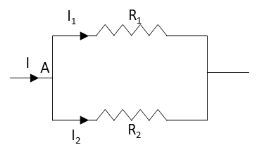
Answer
413.1k+ views
Hint:The word “equivalent” means the total. To derive the expression for effective resistance in the parallel combination of the two resistors, draw the circuit diagram of the two resistors connected parallel to each other. Use Kirchhoff’s current law to express the current at the junction to derive the expression.
Complete step by step answer:
Equivalent resistance is nothing but the total resistance in the circuit. If we connect the number of resistors one after another to the same wire, the total resistance of the wire increases because the resistance of each resistor adds up. Also, when we connect the number of resistors parallel to each other, the total resistance of the circuit decreases. Thus, we can say that the equivalent resistance is the resistance encountered by the whole circuit.Let the two resistors are connected in parallel combination as shown in the figure below.

We know that the voltage in the parallel arm remains the same. Therefore, the voltage across the resistor \[{R_1}\] and the voltage across the resistor \[{R_2}\] is the same.Applying Kirchhoff’s current law at the junction A in the above circuit, we get,
\[I = {I_1} + {I_2}\]
Using Ohm’s law, we can write the above equation as,
\[\dfrac{V}{{{R_{eff}}}} = \dfrac{V}{{{R_1}}} + \dfrac{V}{{{R_2}}}\]
Here, \[{R_{eff}}\] is the effective resistance of the two resistors and V is the voltage which is the same across the two resistors.
Simplifying the above equation, we get,
\[\dfrac{1}{{{R_{eff}}}} = \dfrac{1}{{{R_1}}} + \dfrac{1}{{{R_2}}}\]
\[ \therefore {R_{eff}} = \dfrac{{{R_1}{R_2}}}{{{R_1} + {R_2}}}\]
This is the required expression for the effective resistance of the two resistors connected parallel to each other.
Note:Students can also derive the expression for effective resistance in the series combination of the two resistors in the same manner as we have done in the above section. Remember, the current remains the same in series combination and the voltage remains the same in parallel combination. This is the key to derive the expression for both effective resistances in the series combination and the parallel combination. Also, students should remember KVL and KCL.
Complete step by step answer:
Equivalent resistance is nothing but the total resistance in the circuit. If we connect the number of resistors one after another to the same wire, the total resistance of the wire increases because the resistance of each resistor adds up. Also, when we connect the number of resistors parallel to each other, the total resistance of the circuit decreases. Thus, we can say that the equivalent resistance is the resistance encountered by the whole circuit.Let the two resistors are connected in parallel combination as shown in the figure below.

We know that the voltage in the parallel arm remains the same. Therefore, the voltage across the resistor \[{R_1}\] and the voltage across the resistor \[{R_2}\] is the same.Applying Kirchhoff’s current law at the junction A in the above circuit, we get,
\[I = {I_1} + {I_2}\]
Using Ohm’s law, we can write the above equation as,
\[\dfrac{V}{{{R_{eff}}}} = \dfrac{V}{{{R_1}}} + \dfrac{V}{{{R_2}}}\]
Here, \[{R_{eff}}\] is the effective resistance of the two resistors and V is the voltage which is the same across the two resistors.
Simplifying the above equation, we get,
\[\dfrac{1}{{{R_{eff}}}} = \dfrac{1}{{{R_1}}} + \dfrac{1}{{{R_2}}}\]
\[ \therefore {R_{eff}} = \dfrac{{{R_1}{R_2}}}{{{R_1} + {R_2}}}\]
This is the required expression for the effective resistance of the two resistors connected parallel to each other.
Note:Students can also derive the expression for effective resistance in the series combination of the two resistors in the same manner as we have done in the above section. Remember, the current remains the same in series combination and the voltage remains the same in parallel combination. This is the key to derive the expression for both effective resistances in the series combination and the parallel combination. Also, students should remember KVL and KCL.
Recently Updated Pages
How many sigma and pi bonds are present in HCequiv class 11 chemistry CBSE

Mark and label the given geoinformation on the outline class 11 social science CBSE

When people say No pun intended what does that mea class 8 english CBSE

Name the states which share their boundary with Indias class 9 social science CBSE

Give an account of the Northern Plains of India class 9 social science CBSE

Change the following sentences into negative and interrogative class 10 english CBSE

Trending doubts
Fill the blanks with the suitable prepositions 1 The class 9 english CBSE

Which are the Top 10 Largest Countries of the World?

Give 10 examples for herbs , shrubs , climbers , creepers

Difference Between Plant Cell and Animal Cell

Difference between Prokaryotic cell and Eukaryotic class 11 biology CBSE

The Equation xxx + 2 is Satisfied when x is Equal to Class 10 Maths

Change the following sentences into negative and interrogative class 10 english CBSE

How do you graph the function fx 4x class 9 maths CBSE

Write a letter to the principal requesting him to grant class 10 english CBSE



